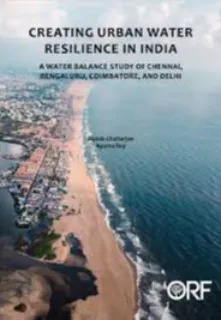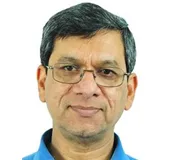Much of urban India faces severe water stress conditions due to rapid urbanisation and population growth, coupled with negligible corresponding additions to raw water sources, archaic water infrastructure and governance issues. A substantial number of India’s 377 million urban residents face water shortages, while about 200,000 die each year from inadequate or unsafe water supplies.1 The further deterioration of India’s water resources will have ramifications on the health, safety and sanitation needs of its people. This study attempts to establish if a comprehensive water balance approach along with integrated urban water management practices could be the solution to India’s urban water woes. Based on primary and secondary data, this study undertakes a comprehensive analysis of the water supply and demand scenarios in four water-stressed cities in India—Chennai, Coimbatore, Bengaluru and Delhi. It analyses the key aspects of urban water management—water source security, distribution, losses due to leaky infrastructure, demand management, water budget optimisation and prudent water governance.
A detailed situation analysis suggests that while Chennai, Bengaluru and Delhi have been constrained by space for growth, Coimbatore has been able to amalgamate large peri-urban areas within the city limits. The populations of Bengaluru grew from about 10,000 per square kilometre in 2001 to 15,000 square kilometre in 2020; of Delhi grew from about 14,000 per square kilometre in 2001 to 20,000 per square kilometre in 2020; and of Chennai increased from approximately 24,000 per square kilometre in 2001 to approximately 47,000 per square kilometre in 2020. However, the population of Coimbatore declined from about 15,000 per square kilometre in 2001 to about 11,000 per square kilometre in 2020. Given their decades-old water supply and sewerage infrastructures, all four cities are dependent on captive sources of raw surface water. Coimbatore and Chennai’s captive storages are in the same river basins that drain the two cities, making them vulnerable to unpredictable climate change impacts. Bengaluru and Delhi, on the other hand, draw piped water from extra-basinal captive sources. With between 20 percent to 50 percent water leakages in these four cities, the resultant reduced per capita raw water availability ranges between approximately 10,000 and 30,000 litres per annum. Large peri-urban and slum areas in all four cities do not have piped water supply. Uncertain and low per capita water availability means an increased reliance on groundwater at a unit dwelling level. Between 10 percent to 30 percent of the net raw water resource comes from groundwater in these cities. However, all four cities are currently mining groundwater at 130 percent to 170 percent of the annual dynamic recharge.
Most Indian cities conduct limited or no segregation of grey and black water discharges. Established urban sewage treatment capacities range between 60 percent to 200 percent of the total sewage generation in the four cities studied. However, a large part of wastewater is discharged into unlined stormwater channels, which leads to the contamination of the stormwater drainages and the groundwater aquifers. Most sewage treatment plants function inefficiently and, consequently, most of the treated outflow does not meet the desired reusable water quality. As a result, the cities face water pollution concerns, such as high total dissolved solids, high electrical conductivity, variable amounts of toxic metal content, low dissolved oxygen, high biological oxygen demand, high chemical oxygen demand, and presence of E-coli in piped water and groundwater due to sewage mixing with leaky pipelines or infiltrating the groundwater systems from unlined conduits.
This report concludes that transitioning from the current linear water balance framework and corresponding governance structure into a circular water balance framework regulated through an Integrated Urban Water Management (IUWM) process is necessary to optimise available water resources. The adaption of circular water balancing within the IUWM and appropriate governance processes will need increased focus on raw water surface/captive source security; the augmentation of aquifer water through conservation; the harvesting and conservation of urban rainwater for either direct use or groundwater recharge; the use of desalinated water wherever feasible; and the capturing, segregation and differential treatment of black and grey water to ensure optimised reuse. Adopting the IUWM process might necessitate the re-laying and replacement of existing water distribution infrastructure, starting from peri-urban or poorer areas. Data suggests that using a circular water balance framework, and by accounting for the conservation of potential rainfall and treated wastewater, gross water availability increases from 350 million cubic metres (MCM) to 950 MCM in Chennai, from 825 MCM to 1350 MCM in Bengaluru, from 70 MCM to 185 MCM in Coimbatore, and from 1550 MCM to 3250 MCM in Delhi—an increase of between 160 percent to 270 percent in all four cities.
The implementation of circular water balance in an IUWM framework will require significant changes in the current governance model of India’s urban local bodies (ULB). The entire water balancing process, the demand analysis, and long-term and short-term water management planning can be based on both legacy and real-time (sensor based) data acquisition. Relevant qualitative and quantitative water information will include the detailed science-based mapping of urban surface water and groundwater sources, water supply and drainage networks, and discharge conduits. The ULBs will need significant training and capacity building to capture, analyse and plan water management in an IUWM framework. Urban citizens will need to be made participants in the IUWM process. Citizens must be encouraged to practice pragmatic demand optimisation and accept that reducing non-revenue water is the key to sustainable urban water security.
The proposed strategy to ensure water security for Indian cities integrates with the Ministry of Jal Shakti’s aspiration to provide piped potable water supply to 2.86 crore households by 2024. It also addresses goal 6 (clean water and sanitation) and 6.5 (implement water resource management) of the UN’s Sustainable Development Goals.
Read the entire monograph here.
The views expressed above belong to the author(s). ORF research and analyses now available on Telegram! Click here to access our curated content — blogs, longforms and interviews.

 PDF Download
PDF Download



 PREV
PREV



